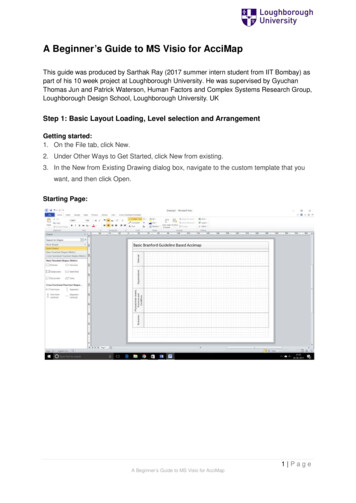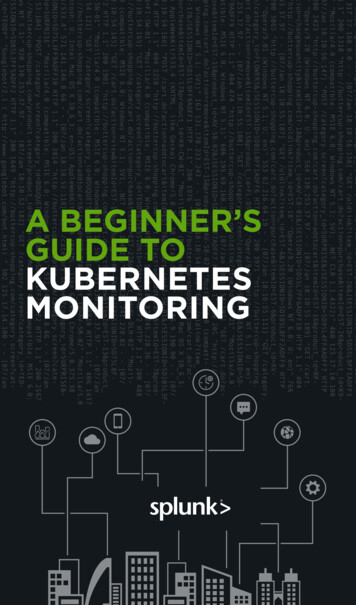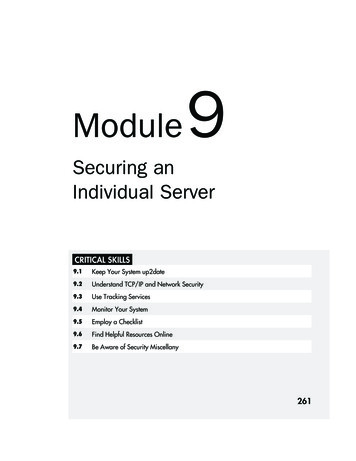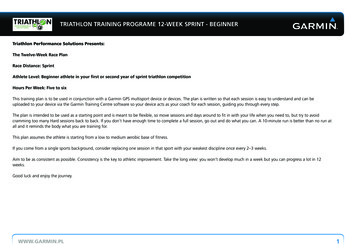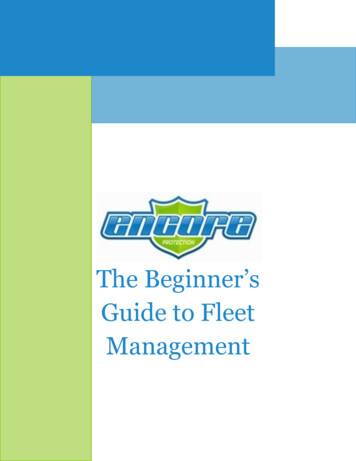
Transcription
A Beginner’s Guide to DataSecurity and InformationSecurity Compliance Audits
Copyright 2012 Latitude Software All rights reserved.Copyright 2012 Interactive Intelligence Group Inc. All rights reservedCopyright 2012 insideARM, LLC. All rights reserved.Brand and product names referred to in this document are the trademarks or registeredtrademarks of their respective companies.Latitude Software7800 Belfort Parkway, Suite 100Jacksonville, FL 32256Telephone: 904.680.7100Toll Free: 866.396.2599www.Latitude-Software.comInteractive Intelligence Group Inc.7601 Interactive WayIndianapolis, IN 46278Telephone/Fax: 317.872.3000www.ININ.cominsideARM, LLC6010 Executive Blvd.Suite 802Rockville, MD 20852Telephone: 240.499.3836www.insideARM.comRev. 01.12, version 1Interactive Intelligence Group Inc.2A Beginner’s Guide to Data Security & Information Security Compliance Audits
Table of ContentsIntroduction . 4Data security . 5Goals for a comprehensive data security program . 510 steps to data security . 5Information security compliance audits . 8Security frameworks. 9Implementation best practices . 10Now it’s time for the audit . 11Remediation . 11Conclusion. 12One, and not done. 12Contributors . 14Interactive Intelligence Group Inc.3A Beginner’s Guide to Data Security & Information Security Compliance Audits
IntroductionIf your company isn’t focused on compliance, more than just your reputation is at risk.ARM performance is no longer only measured in terms of liquidation, dollars collected,and right-party contacts per hour. Overall performance is now inclusive of thecompliance and quality practices that your firm maintains and adheres to. Compliance isat once a legal requirement, a risk management strategy, an ethical imperative, and anunavoidable line item on most companies' balance sheets.If you are a third-party collector for a creditor, you are going to be audited. This won'tjust be an audit of your recovery performance; it will be an audit of your compliancepractices. Less than exemplary compliance, in appearance or actuality, can hurtcreditors in the marketplace, and that's a risk more and more creditors are no longerwilling to take. In this era of heightened consumer lawsuits, no debt collection companycan be effective in this industry while also shirking the responsibility to be fullycognizant of compliance issues.This Beginner's Guide should be seen as a primer for the accompanying webinar,presented by Interactive Intelligence, Latitude Software, and insideARM.com onFebruary 2, 2012. The tips and talking points introduced here will be part of anexpanded conversation in a workshop setting. Our thanks to Flavio Villanustre, VP ofData Security at Lexis Nexis, and Belinda Hickling, Director of Information Security atLatitude Software, for their input and participation.Interactive Intelligence Group Inc.4A Beginner’s Guide to Data Security & Information Security Compliance Audits
Data securityRecent global trends indicate a proliferation of data originating from multiple sourcesand permeating throughout all business areas. Nowadays, thanks to the growth of theInternet and social networks, not only do organizations have a need to deal withinternally generated data records, but also with a substantial amount of external datacollected in the course of normal business activities. All this data can create a significantrisk for the organization if leaked or misappropriated, and costs to recover from it canbe as high as 214 per record, as reported in a study performed by Ponemon Instituteand Symantec in May 2011.In addition, different laws and regulations may require specific data retention schedulesfor particular data types – and the penalties for non-compliance can be steep. Ongoinglitigation is another factor that can suddenly force data retention schedule changes –requiring adequate communication channels across the organization and an effectivetracking and management system to ensure compliance.Goals for a comprehensive data security programWhen designing a comprehensive data security program, there are different aspectsthat need to be considered in order to adequately mitigate the risks. Identifying thedifferent data types, and classifying them based on company needs and legal andregulatory frameworks, allows for a straightforward determination around data value,protective measures to implement, and retention requirements.Data security cannot be implemented in a vacuum: it needs to be part of a coordinatedcomprehensive information security program and, as such, it will need adoption andsupport from the top of the organization. Executive buy-in and sponsorship are crucialfor any respectable long term program.10 steps to data security1. Inventory: Know which data you have and where it resides. Label your datarepositories and your data records, if at all possible. Use these labels to trackthe individual data records along their lifetimes, and maintain electronic logs.2. Research the laws and regulations that could apply to this data and the controlsthat they require.a.b.c.d.e.f.g.Is encryption of data at rest required?For how long should this data be retained?Is there any ongoing litigation that would require retaining this data fora longer period of time?What is the value to the business?What is the risk level associated with the loss/exposure?Is some of this data subject to the credit card industry PCI compliance?Do I need an offsite backup of this data?Interactive Intelligence Group Inc.5A Beginner’s Guide to Data Security & Information Security Compliance Audits
3. Access controls: Identify the groups that should have access to the data andcompare with the list of people that should have access based on datasensitivity or regulatory requirements. Next stepis to correct the gap. You’ll also want to preventThe principle of least privilegeunauthorized access to the data by implementingrequires that every module withinan adequate authorization process during accessa data environment (process,useror program), must be able toprovisioning. Ensure an expedited accessaccess only the information andrevocation process upon job role changes orresources that are necessary forterminations. Put in place a periodic accesslegitimate work purposes.review process. Ensure that data is madeavailable only on a need to know basis andexercise a “least privilege principle” whengranting access to data repositories.4. Application Security: Review the security of the applications that have access toyour data. If some of these applications are built in-house, implement a SecureDevelopment Lifecycle process, providing defensive coding practices training,fostering code reviews, and performing periodicapplication security assessments. If there areTokenization is the process ofreplacing some piece of sensitivecommercial off-the-shelf applications, ensuredate (for example, a credit cardthat vendor notifications on security problemsnumber), with a value that isand vulnerabilities are promptly handled, andreplaced with a random value thatupdates and patches are swiftly deployed.is not sensitive, (for instance a “*”in place of the numbersIdentify the different data elements and utilizethemselves).tokenization techniques to mask those sensitiveelements that are not an absolute requirementfor a particular process.5. Infrastructure Security: There are several critical components in this area.1. Verify that any external access to data repositories is properly vetted, andthat adequate isolation is in place across the network architecture.2. Physical access controls where applicable are paramount.3. Implement a data disposal program to ensure that magnetic and nonmagnetic media is securely wiped before their removal from the secureenvironments.4. Deploy data encryption at rest and/or full disk encryption if any datarepositories leave the secure perimeter (laptops, mobile devices, offsitebackups).5. Ensure that transmission channels are encrypted for sensitive data.6. Implement two-factor authentication if external access is required tosensitive data.Interactive Intelligence Group Inc.6A Beginner’s Guide to Data Security & Information Security Compliance Audits
6. Data retention policies: Define a consistent data retention policy andcommunicate it across the organization. Avoid complex classifications and keepthe number of categories to the minimum required by law, regulations orcompany needs.7. Data loss prevention: Implement a data loss prevention system to detect andblock accidental and/or intentional data leaks.8. The human factor: Require background screening as part of your hiring andcontracting practices. Provide regular awareness campaigns and training arounddata security and cyber threats.9. Audit: Assess regularly the effectiveness of all these measures, and applycorrective actions to improve these controls over time.10. Transfer your residual risk: : If, after applying the steps above you determinethat the residual risk is still not acceptable to the level of risk tolerance of theorganization, you can transfer part of this risk by contracting an insurance policyto cover for some of it.The importance of data security, as part of a comprehensive information securityprogram, has increased significantly in recent years. Ignorance, when it comes to datarisks, is certainly not bliss. Hiding your head in the sand will just increase chances for adisaster.If at all possible, rely on a standard framework for your information security program(ISO 27001/2 is probably one of the most widespread ones), and assume thateventually, things could go wrong. In extreme cases, data breaches and their associatedcleanup costs can cost companies hundreds of millions of dollars, as the incident withSony PlayStation Network proved in 2011.Interactive Intelligence Group Inc.7A Beginner’s Guide to Data Security & Information Security Compliance Audits
Information security compliance auditsIt may be best to start by sitting down to answer three high level questions with regardsto information security compliance:1. What are you trying to accomplish? Begin by clearly defining yourrequirements.2. Which compliance framework are you trying to achieve? How familiar areyou with the various compliances and certifications? Do your research tohelp determine those that most cleanly align with your requirements.a.b.c.d.e.f.PCI-DSS 2.0SSAE-16 (replaces SAS 70)ISO1799 27001 (compliance)ISO 17799 (certification)COBitCOSO3. Who or what is driving your compliance efforts? Be sure to include allstakeholders and influencers. Many times compliance efforts are driven byclients. When that’s the case, it’s also in your best interest – take the timeto first ensure that their requirements are legitimate and appropriate foryou organization.a. Predefined by client. Ask forclarification on the issues andpressures driving this compliancerequirement.b. Ensure that the compliancerequirements are legitimate andappropriate for your organization.As a provider of collectionsdesktop applications, LatitudeSoftware was requested by aclient to comply withRed Flags rule.After consulting with an externalsecurity partner we determinedthat Latitude was not within scopeof this particular requirement andwe were able to strike it from ouragreement.c. Own choosing. You’ll need toresearch the pros and cons of thevarious general securityframeworks to determine whichone(s) are best for your organization and clients.4. Make sure you have senior level or executive support, as these effortsare typically time consuming and costly.Interactive Intelligence Group Inc.8A Beginner’s Guide to Data Security & Information Security Compliance Audits
Security frameworksA security or compliance framework maps to a set of compliance standards thatperform a series of checks following broadly accepted best practices or controls,ensuring that IT infrastructure, applications, business services and processes areorganized, configured, managed, and monitored correctly.The below list is just a sample of the many security frameworks. This list is not meant tobe exhaustive but merely provide a sample of common audits that are in use today.Type of CertificationWho is it for?AdditionalinformationISO/IEC 27001:2005Organizations whohave implemented theISO/IEC 27002: 2005standard and want tovalidate their controlswith a qualified ITcertification bodyReleased in 2005 theISO 27001 is thecertification to the ISO27002 controlsCertificationPCI DSS 2.0Companies, that store,transmit or processcredit card dataThe Payment CardIndustry Data SecurityStandard (PCI DSS) is amultifaceted securitystandard that includesrequirements forsecurity management,policies, procedures,network architecture,software design andother critical rganizations thathave implemented asecurity frameworkand want to attest toits validityThe SSAE-16 auditvalidates anorganization’scompliance to a seriesof trust, confidentialityand security controlsAttestation performed by acertified American Instituteof Certified PublicAccountants (AICPA) auditor.Available in SOC1, SOC2, orSOC 3 formSarbanes OxleyPublicly tradedcompaniesThe Act requiresimproving andsafeguarding thereliability andtransparency ofaccounting statementsand regulatory filingsComplianceInteractive Intelligence Group Inc.9Certification/ComplianceA Beginner’s Guide to Data Security & Information Security Compliance Audits
Implementation best practicesOnce you have decided on a compliance framework, here are some best practices forimplementation of your compliance initiative.Gain management approval – You need to have an executive level or seniorsponsor for your endeavor; otherwise it will most likely not succeed. The seniormanager should communicate to the organization explaining that this is a highpriority for your organization and that it requires their full support. You shouldprovide sponsors with regular updates and advise them of any risks or issueswith the project.Know your business or allocate the appropriate resources – It is very difficultfor one person to know everything about an organization. Ensure you have agood representation of your organization within your team. If you don’t havethe appropriate security resources internally then supplement them withoutside resources.Define your scope – It is extremely easy to get carried away. Make sure that youand your team understand specifically what you are trying to accomplish.Identify a security auditor to assist you with your compliance goal – Look forreferrals by others in your vertical. Make sure to obtain multiple quotes and geta good understanding of what their deliverables will look like and that you arecomparing apples to apples.Budget – Make sure to include soft costs for tools, resources as well as the costof your audit.Complete a gap assessment* –This step is imperative as it allows you to seewhat and where your gaps are – and it defines how much time you will need toensure compliancy. Typically an auditor or auditors will come to your locationand interview any applicable representatives within scope. It is imperative thatthe employees are upfront with the auditors regarding existing practices;otherwise you will not get a true representation of the risks to yourorganization.[* I would not commit to a project completion date until you have completedthis step, it’s difficult to determine how long an audit is going to take until youhave a good understanding what your gaps actually are.]Assign Tasks –Once you have identified the gaps, identify the priority, ownersand required time frame to remediate said gaps.Interactive Intelligence Group Inc.10A Beginner’s Guide to Data Security & Information Security Compliance Audits
Now it’s time for the auditOnce you have completed your application and initial remediation phase, you will needto compile evidence for the onsite audit of your existing controls. The extent of theaudit will be based on the type of compliance (certification, accreditation or attestation)that you are completing.Note: If you have questions or disagree with the auditor, do not hesitate to askquestions. Audits are subjective by nature, so make sure that you have a goodunderstanding of why you are being required to do something, or why a controlthat you have implemented is not sufficient. If you have a good response as towhy your control meets the requirement then let the auditor know; they will atleast give you information as to why your control is deficient.Once the audit has been completed, there is typically a final remediation period tocompile any additional evidence or implement supplemental controls.RemediationThe idea here is to reduce the risk to your business by implementing one of thefollowing:Risk transfer – Whereby risk is transferred to another party by outsourcingservices or purchasing insurance to cover said risk.Risk mitigation – Using tools, resources, or some other means to mitigate therisk to an acceptable level. Be careful here; you need to make sure that the costof your countermeasure does not exceed the risk you are trying to mitigate.Perform a cost/benefit analysis on your proposed solution(s), including theprobability that the remediation will in fact mitigate your risk.Risk acceptance – Typically only done when the item is a low risk and the cost tomitigate is not going to impede your business in a negative manner.Once sufficient evidence has been provided the auditor will prepare a final report ordeliver the required certification, etc.Interactive Intelligence Group Inc.11A Beginner’s Guide to Data Security & Information Security Compliance Audits
ConclusionOne, and not doneCompliance is not a one-time checklist. Most compliance audits require that youundertake additional audits to confirm continued compliance on a regular basis. It iseasy for management to get caught up in the fact that “We have this, so now let’s moveon to the next initiative.” That simply will not work. Typically, follow-up audits are morestringent than the originals as they require that you show evidence from the time of thepreceding audit –not just at a single point in time (as might have been required for theoriginal audit).Remember that an audit is simply an external review of your controls specific to acertification or compliance. An auditor may not find all of your issues; therefore, it isyour responsibility to stay well versed and in-touch with any certification criteriachanges and how it may impact your environment.The ARM industry is a highly regulated and heavily scrutinized industry. As such, there isno one-stop compliance-shop or magic bullet that can address the complex challengesARM service providers face every day as they strive to achieve compliance. Use thispaper and the accompanying February 2, 2012 webinar as a launching pad to assessyour own compliance-related business needs in order to grow your company and helpsafeguard the reputation of the ARM industry as a whole.Interactive Intelligence Group Inc.12A Beginner’s Guide to Data Security & Information Security Compliance Audits
Kaulkin Media, publisher of insideARM.com, provides the most credible platform forservice providers to reach potential clients, and is also uniquely qualified to help ARMbusinesses with their own websites, social media programs, and overall marketingstrategies.The mission of insideARM.com is to shift the public conversation about the ARMindustry in order to help creditors and collection professionals reduce risk, lawsuits, andbad press; we’d like to change consumer perception that speaking with collectorsshould be avoided. With over 70,000 subscribers our website and newsletters reachcollection agencies and law firms, debt buyers, credit grantors, suppliers of technologyand services to these groups, regulators, industry investors, and many other interestedparties. Visit www.insidearm.comInteractive Intelligence and its subsidiary, Latitude Software, provide on-premise andcloud-based dialer and debt collection software solutions for accounts receivablemanagement. Interactive Intelligence outbound dialing software increases agentutilization and right-party contacts, eliminates workforce segmentation, and maintainscompliance. Latitude debt collection software and services are easy to use and offercomprehensive functionality for faster, more effective debt collection and portfoliorecovery. Visit inin.com or debtsoftware.com for more information.Deliberately Innovative All-in-One Communications for Business. Interactive IntelligenceGroup Inc. is a global provider of unified business communications solutions for contactcenter automation, enterprise IP telephony, and business process automation. Thecompany’s standards-based all-in-one communications software suite was designed toeliminate the cost and complexity of multi-point systems. Founded in 1994 and backedby more than 4,000 customers worldwide, Interactive Intelligence is an experiencedleader in delivering customer value through its on-premise or cloud-basedCommunications as a Service (CaaS) solutions, both of which include software,hardware, consulting, support, education and implementation.At Interactive Intelligence, it’s what we do.Interactive Intelligence Group Inc.13A Beginner’s Guide to Data Security & Information Security Compliance Audits
ContributorsFlavio Villanustre is the Vice President of Information Securityfor LexisNexis Risk Solutions. In this position, Mr. Villanustre isresponsible for information and physical security and overallinfrastructure strategy. Previously, Flavio was Director ofInfrastructure for Seisint, Inc. Prior to 2001, Flavio served in avariety of roles at different companies including infrastructure,information security and information technology.Belinda Hickling is the Information Security Officer and Directorof Hosted Services for Latitude Software. Belinda is anInformation technology professional with 12 years ofprogressive management responsibility in corporate security,and has experience in security strategic planning andmanagement, auditing, project management, risk managementstrategies, compliance, security technologies, and developingsecurity programs for both the financial and software sectors.In addition to managing Latitude’s security needs, Belinda also directs operations in theLatitude hosted environment. She was instrumental in Latitude obtaining the covetedISO 17799 27001 certification for Latitude’s Hosted/SaaS environment in 2011 and iscurrently heading up the Interactive Intelligence SSAE-16 initiative for their CaaS group.Prior to Belinda’s tenure with Latitude in 2007, she gained invaluable experience in thecollections industry by assisting the tremendous growth of Focus ReceivablesManagement over a period of seven years. During that time she held ever increasingmanagement responsibilities culminating in her ultimate position as VP of Technologyand Customer Support. As with Latitude, she was instrumental in obtaining ISOcertification and earned the second highest compliance rating with limited budget andpersonnel.Interactive Intelligence Group Inc.14A Beginner’s Guide to Data Security & Information Security Compliance Audits
Interactive Intelligence Group Inc. 6 A Beginner’s Guide to Data Security & Information Security Compliance Audits . The . principle of least privilege. requires that every module within a data environment (process, user or program), must be able to access
